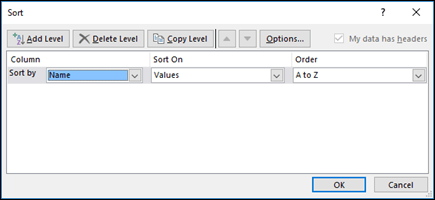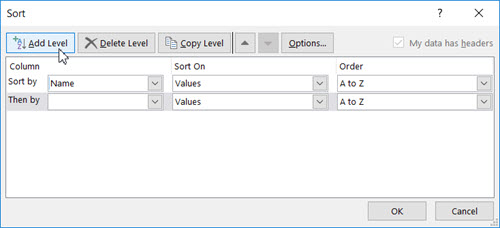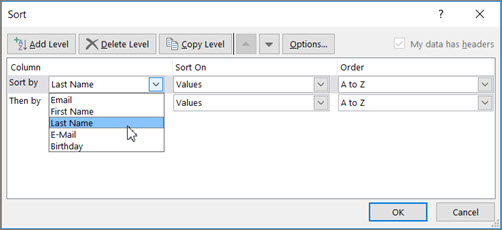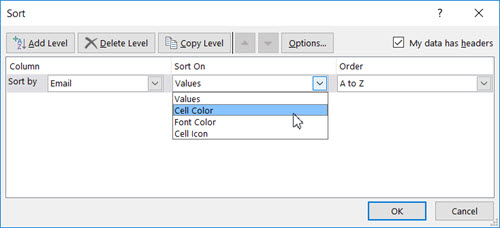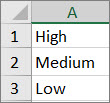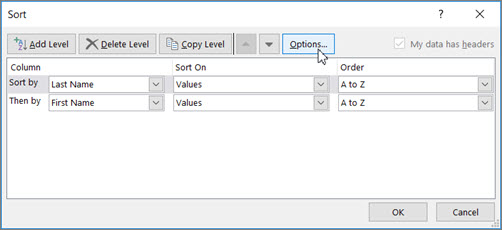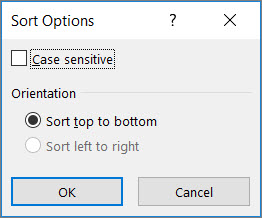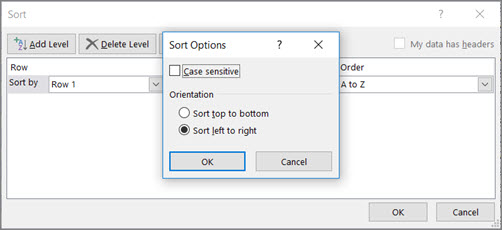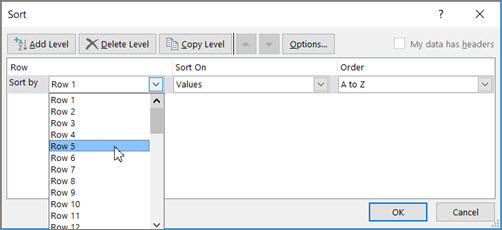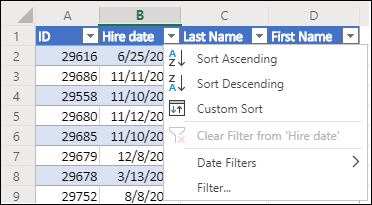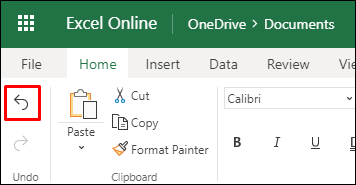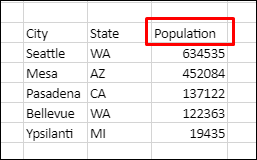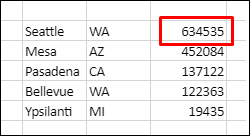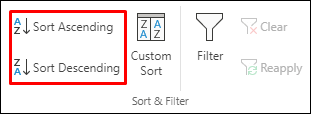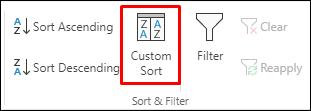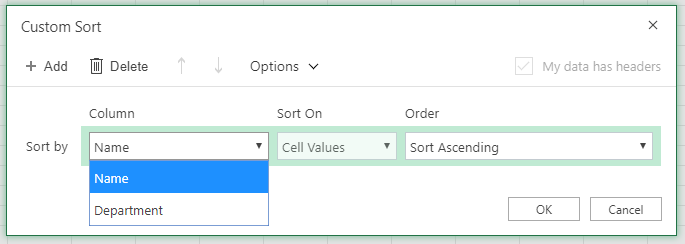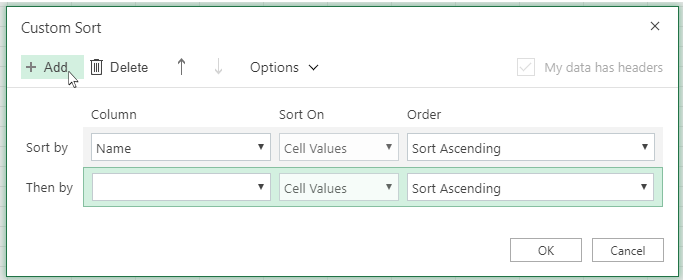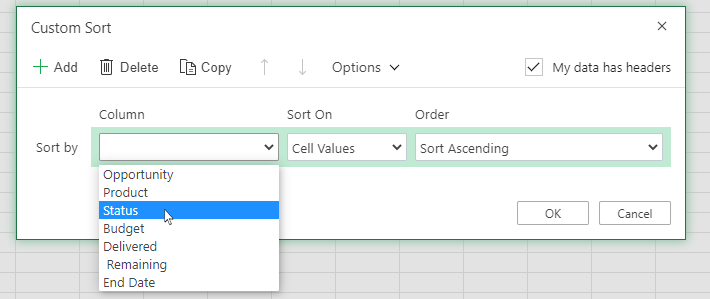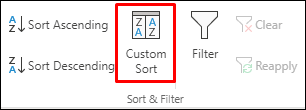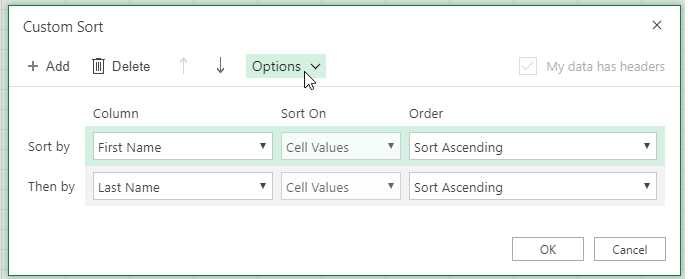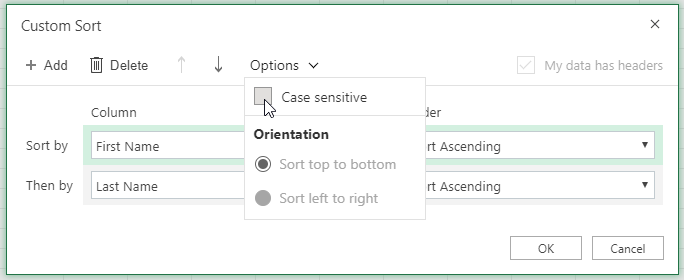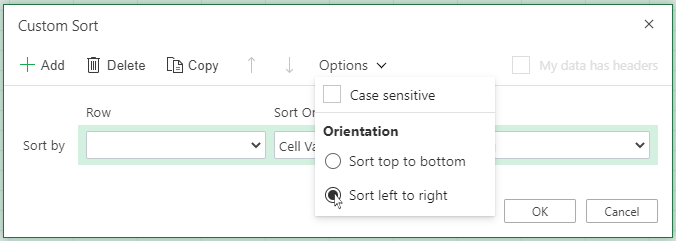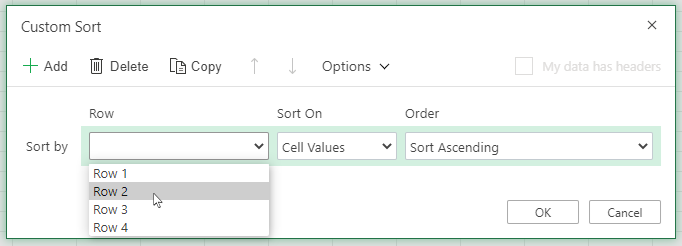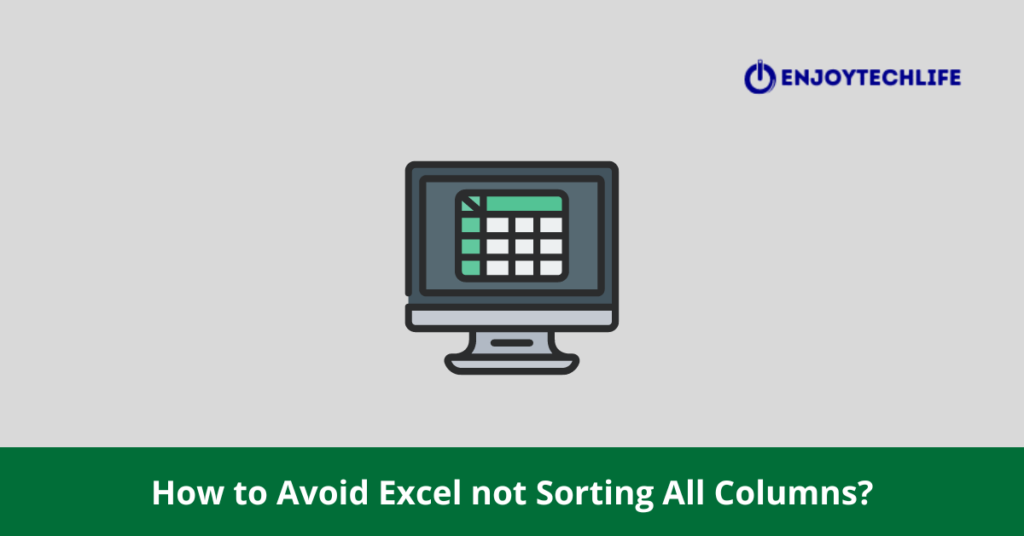I have a very basic worksheet with multiple columns and rows. I usually will sort one column to sort a-z and normally all data for those rows would follow the sort. Suddenly I am finding that if I sort one column, the remaining columns do not sort, even though I choose the «Expand The Selection». I have also noticed that after sorting, the worksheet is split into one set of columns on the left side that did sort, another set of columns on the right did not follow the sort. It is split. I have about 45 columns and 150 rows so the worksheet is particularly large.
Completely befuddled.
asked Dec 20, 2015 at 16:31
3
This happens when all the column is not a part of one table, even though it is within one sheet.
- Ctrl + A
- Clear all filters or sorting. Home tab -> Sort & Filter -> Clear
- Make sure that the headings are only present in the first column.
- Select the complete table region only.
- Home tab -> Format Table As -> Choose any of the options and check the heading available when prompted.
- Try sorting it either ways and it should work for all columns.
answered Jul 2, 2018 at 14:04
I have found in some circumstances that the table simply needs to be resized.
Follow these steps and see if they help:
1) click anywhere within your table
2) click Design
3) at the far left of the ribbon, click Resize Table
4) fix the data range so that the entire table is within the range, i.e. if the range says, C1:E114, and the A and B columns through row 114 should be included in range, adjust the range to A1:E114.
Hope this helps when all else fails.
answered Sep 24, 2018 at 8:52
Excel automatically tries to find your total data range, and it stumbles over blank fields. So if your cursor is in a line where there a blank fields in some columns, Excel could miss the columns behind the blanks fields (and similar for blank rows). This is still true when you chose ‘extend’.
One solution is to 1. use Autofilters, that will make Excel remember what is in your range; another is to 2. put the cursor in a field where there are no blank fields in the row (and column); a third way is to 3. select the whole range yourself; and of course, the problem goes away if you 4. don’t have blank cells anywhere.
I recommend the Autofilter solution if it doesn’t bother you otherwise, as it makes sure that you don’t accidentally sort some day a part only because you forgot to do 2. or 3.
answered Dec 21, 2015 at 2:24
AganjuAganju
9,8843 gold badges21 silver badges40 bronze badges
In my case it was because I had empty hidden columns between the content columns and for some reason Excel was considering them as some sort of separator. For example if I clicked Ctrl + A while having a cell selected, it would only select the columns between the nearest empty columns.
In order to fix this, remove the empty columns.
answered Jun 13, 2017 at 20:03
If you selected yourself the range of cells, and it does not sort properly, you may have created tables within what you consider your table. To find out:
- Go right above the first line, on the top left, where the cell number appears (
F16,M34, whatever) - Select the arrow going down.
- Case a) nothing appears, it is all blank, then just try the solutions in the other comments
- Case b) some stuff appears. If so, these are tables, you need to get rid of them (it does not delete your cells)
To get rid of the tables:
- Click on each of the lines that appeared (the ones that appeared in case b). Basically, when you click on one, a bunch of cells are highlighted.
- Right click on any of the highlighted cells (basically you are right clicking on the whole range anyway)
- Go to table and delete the table (if «table» is not part of the menu when you right click, you did not have any table created)
- Repeat these steps for all of the tables (i.e., for each line that appeared when you clicked on the drop down menu next to the cell name)
You can now happily sort your data.
answered Dec 18, 2017 at 3:59
SamiaSamia
11 bronze badge
Does your data have filters? If so, select header row with filters, then remove all filters (right click, Filter, clear filter). Then select header row again, and add filters back. After doing so I was able to sort my data and all columns sorted. Hope this helps!
answered Jun 20, 2018 at 14:00
You most probably added new columns after filtering former columns, so new column headers «have NOT filter signs». Excel exclude these columns when you filter.
So, clear filtering by clicking on Sort$Fliter>Filter, then add the filter sign to «all» columns again by hitting the Filter button again. There you go!
answered Jun 11, 2022 at 16:44
I have a solution.
U have to have Sort column next to your data and it will do the right thing.
Hope will help u.
answered Jan 5, 2017 at 22:45
1
Excel puts blanks at the bottom when you sort.
- Ctrl-G (Go to)
- Click Special
- Check Blanks, click OK
All blanks will now be selected. Select a background color to change all blank cells.
Now you can sort by color and have blanks appear at the top.
answered Feb 14, 2017 at 19:43
1

Sorting data is an integral part of data analysis. You might want to arrange a list of names in alphabetical order, compile a list of product inventory levels from highest to lowest, or order rows by colors or icons. Sorting data helps you quickly visualize and understand your data better, organize and find the data that you want, and ultimately make more effective decisions.
You can sort data by text (A to Z or Z to A), numbers (smallest to largest or largest to smallest), and dates and times (oldest to newest and newest to oldest) in one or more columns. You can also sort by a custom list you create (such as Large, Medium, and Small) or by format, including cell color, font color, or icon set.
Notes:
-
To find the top or bottom values in a range of cells or table, such as the top 10 grades or the bottom 5 sales amounts, use AutoFilter or conditional formatting.
-
For more information, see Filter data in an Excel table or range, and Apply conditional formatting in Excel .
Sort text
-
Select a cell in the column you want to sort.
-
On the Data tab, in the Sort & Filter group, do one of the following:
-
To quick sort in ascending order, click
(Sort A to Z).
-
To quick sort in descending order, click
(Sort Z to A).
-
Notes:
Potential Issues
-
Check that all data is stored as text If the column that you want to sort contains numbers stored as numbers and numbers stored as text, you need to format them all as either numbers or text. If you do not apply this format, the numbers stored as numbers are sorted before the numbers stored as text. To format all the selected data as text, Press Ctrl+1 to launch the Format Cells dialog, click the Number tab and then, under Category, click General, Number, or Text.
-
Remove any leading spaces In some cases, data imported from another application might have leading spaces inserted before data. Remove the leading spaces before you sort the data. You can do this manually, or you can use the TRIM function.
-
Select a cell in the column you want to sort.
-
On the Data tab, in the Sort & Filter group, do one of the following:
-
To sort from low to high, click
(Sort Smallest to Largest).
-
To sort from high to low, click
(Sort Largest to Smallest).
-
Notes:
-
Potential Issue
-
Check that all numbers are stored as numbers If the results are not what you expected, the column might contain numbers stored as text instead of as numbers. For example, negative numbers imported from some accounting systems, or a number entered with a leading apostrophe (‘) are stored as text. For more information, see Fix text-formatted numbers by applying a number format.
-
Select a cell in the column you want to sort.
-
On the Data tab, in the Sort & Filter group, do one of the following:
-
To sort from an earlier to a later date or time, click
(Sort Oldest to Newest).
-
To sort from a later to an earlier date or time, click
(Sort Newest to Oldest).
-
Notes:
Potential Issue
-
Check that dates and times are stored as dates or times If the results are not what you expected, the column might contain dates or times stored as text instead of as dates or times. For Excel to sort dates and times correctly, all dates and times in a column must be stored as a date or time serial number. If Excel cannot recognize a value as a date or time, the date or time is stored as text. For more information, see Convert dates stored as text to dates.
-
If you want to sort by days of the week, format the cells to show the day of the week. If you want to sort by the day of the week regardless of the date, convert them to text by using the TEXT function. However, the TEXT function returns a text value, so the sort operation would be based on alphanumeric data. For more information, see Show dates as days of the week.
You may want to sort by more than one column or row when you have data that you want to group by the same value in one column or row, and then sort another column or row within that group of equal values. For example, if you have a Department column and an Employee column, you can first sort by Department (to group all the employees in the same department together), and then sort by name (to put the names in alphabetical order within each department). You can sort by up to 64 columns.
Note: For best results, the range of cells that you sort should have column headings.
-
Select any cell in the data range.
-
On the Data tab, in the Sort & Filter group, click Sort.
-
In the Sort dialog box, under Column, in the Sort by box, select the first column that you want to sort.
-
Under Sort On, select the type of sort. Do one of the following:
-
To sort by text, number, or date and time, select Values.
-
To sort by format, select Cell Color, Font Color, or Cell Icon.
-
-
Under Order, select how you want to sort. Do one of the following:
-
For text values, select A to Z or Z to A.
-
For number values, select Smallest to Largest or Largest to Smallest.
-
For date or time values, select Oldest to Newest or Newest to Oldest.
-
To sort based on a custom list, select Custom List.
-
-
To add another column to sort by, click Add Level, and then repeat steps three through five.
-
To copy a column to sort by, select the entry and then click Copy Level.
-
To delete a column to sort by, select the entry and then click Delete Level.
Note: You must keep at least one entry in the list.
-
To change the order in which the columns are sorted, select an entry and then click the Up or Down arrow next to the Options button to change the order.
Entries higher in the list are sorted before entries lower in the list.
If you have manually or conditionally formatted a range of cells or a table column by cell color or font color, you can also sort by these colors. You can also sort by an icon set that you created with conditional formatting.
-
Select a cell in the column you want to sort.
-
On the Data tab, in the Sort & Filter group, click Sort.
-
In the Sort dialog box, under Column, in the Sort by box, select the column that you want to sort.
-
Under Sort On, select Cell Color, Font Color, or Cell Icon.
-
Under Order, click the arrow next to the button and then, depending on the type of format, select a cell color, font color, or cell icon.
-
Next, select how you want to sort. Do one of the following:
-
To move the cell color, font color, or icon to the top or to the left, select On Top for a column sort, and On Left for a row sort.
-
To move the cell color, font color, or icon to the bottom or to the right, select On Bottom for a column sort, and On Right for a row sort.
Note: There is no default cell color, font color, or icon sort order. You must define the order that you want for each sort operation.
-
-
To specify the next cell color, font color, or icon to sort by, click Add Level, and then repeat steps three through five.
Make sure that you select the same column in the Then by box and that you make the same selection under Order.
Keep repeating for each additional cell color, font color, or icon that you want included in the sort.
You can use a custom list to sort in a user-defined order. For example, a column might contain values that you want to sort by, such as High, Medium, and Low. How can you sort so that rows containing High appear first, followed by Medium, and then Low? If you were to sort alphabetically, an “A to Z” sort would put High at the top, but Low would come before Medium. And if you sorted “Z to A,” Medium would appear first, with Low in the middle. Regardless of the order, you always want “Medium” in the middle. By creating your own custom list, you can get around this problem.
-
Optionally, create a custom list:
-
In a range of cells, enter the values that you want to sort by, in the order that you want them, from top to bottom as in this example.
-
Select the range that you just entered. Using the preceding example, select cells A1:A3.
-
Go to File > Options > Advanced > General > Edit Custom Lists, then in the Custom Lists dialog box, click Import, and then click OK twice.
Notes:
-
You can create a custom list based only on a value (text, number, and date or time). You cannot create a custom list based on a format (cell color, font color, or icon).
-
The maximum length for a custom list is 255 characters, and the first character must not begin with a number.
-
-
-
Select a cell in the column you want to sort.
-
On the Data tab, in the Sort & Filter group, click Sort.
-
In the Sort dialog box, under Column, in the Sort by or Then by box, select the column that you want to sort by a custom list.
-
Under Order, select Custom List.
-
In the Custom Lists dialog box, select the list that you want. Using the custom list that you created in the preceding example, click High, Medium, Low.
-
Click OK.
-
On the Data tab, in the Sort & Filter group, click Sort.
-
In the Sort dialog box, click Options.
-
In the Sort Options dialog box, select Case sensitive.
-
Click OK twice.
It’s most common to sort from top to bottom, but you can also sort from left to right.
Note: Tables don’t support left to right sorting. To do so, first convert the table to a range by selecting any cell in the table, and then clicking Table Tools > Convert to range.
-
Select any cell within the range you want to sort.
-
On the Data tab, in the Sort & Filter group, click Sort.
-
In the Sort dialog box, click Options.
-
In the Sort Options dialog box, under Orientation, click Sort left to right, and then click OK.
-
Under Row, in the Sort by box, select the row that you want to sort. This will generally be row 1 if you want to sort by your header row.
Tip: If your header row is text, but you want to order columns by numbers, you can add a new row above your data range and add numbers according to the order you want them.
-
To sort by value, select one of the options from the Order drop-down:
-
For text values, select A to Z or Z to A.
-
For number values, select Smallest to Largest or Largest to Smallest.
-
For date or time values, select Oldest to Newest or Newest to Oldest.
-
-
To sort by cell color, font color, or cell icon, do this:
-
Under Sort On, select Cell Color, Font Color, or Cell Icon.
-
Under Order select a cell color, font color, or cell icon, then select On Left or On Right.
-
Note: When you sort rows that are part of a worksheet outline, Excel sorts the highest-level groups (level 1) so that the detail rows or columns stay together, even if the detail rows or columns are hidden.
To sort by a part of a value in a column, such as a part number code (789-WDG-34), last name (Carol Philips), or first name (Philips, Carol), you first need to split the column into two or more columns so that the value you want to sort by is in its own column. To do this, you can use text functions to separate the parts of the cells or you can use the Convert Text to Columns Wizard. For examples and more information, see Split text into different cells and Split text among columns by using functions.
Warning: It is possible to sort a range within a range, but it is not recommended, because the result disassociates the sorted range from its original data. If you were to sort the following data as shown, the selected employees would be associated with different departments than they were before.
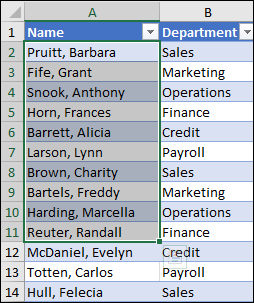
Fortunately, Excel will warn you if it senses you are about to attempt this:

If you did not intend to sort like this, then press the Expand the selection option, otherwise select Continue with the current selection.
If the results are not what you want, click Undo 
Note: You cannot sort this way in a table.
If you get unexpected results when sorting your data, do the following:
Check to see if the values returned by a formula have changed If the data that you have sorted contains one or more formulas, the return values of those formulas might change when the worksheet is recalculated. In this case, make sure that you reapply the sort to get up-to-date results.
Unhide rows and columns before you sort Hidden columns are not moved when you sort columns, and hidden rows are not moved when you sort rows. Before you sort data, it’s a good idea to unhide the hidden columns and rows.
Check the locale setting Sort orders vary by locale setting. Make sure that you have the proper locale setting in Regional Settings or Regional and Language Options in Control Panel on your computer. For information about changing the locale setting, see the Windows help system.
Enter column headings in only one row If you need multiple line labels, wrap the text within the cell.
Turn on or off the heading row It’s usually best to have a heading row when you sort a column to make it easier to understand the meaning of the data. By default, the value in the heading is not included in the sort operation. Occasionally, you may need to turn the heading on or off so that the value in the heading is or is not included in the sort operation. Do one of the following:
-
To exclude the first row of data from the sort because it is a column heading, on the Home tab, in the Editing group, click Sort & Filter, click Custom Sort and then select My data has headers.
-
To include the first row of data in the sort because it is not a column heading, on the Home tab, in the Editing group, click Sort & Filter, click Custom Sort, and then clear My data has headers.
If your data is formatted as an Excel table, then you can quickly sort and filter it with the filter buttons in the header row.
-
If your data isn’t already in a table, then format it as a table. This will automatically add a filter button at the top of each table column.
-
Click the filter button at the top of the column you want to sort on, and pick the sort order you want.
-
To undo a sort, use the Undo button on the Home tab.
-
Pick a cell to sort on:
-
If your data has a header row, pick the one you want to sort on, such as Population.
-
If your data doesn’t have a header row, pick the topmost value you want to sort on, such as 634535.
-
-
On the Data tab, pick one of the sort methods:
-
Sort Ascending to sort A to Z, smallest to largest, or earliest to latest date.
-
Sort Descending to sort Z to A, largest to smallest, or latest to earliest date.
-
Let’s say you have a table with a Department column and an Employee column. You can first sort by Department to group all the employees in the same department together, and then sort by name to put the names in alphabetical order within each department.
Select any cell within your data range.
-
On the Data tab, in the Sort & Filter group, click Custom Sort.
-
In the Custom Sort dialog box, under Column, in the Sort by box, select the first column that you want to sort.
Note: The Sort On menu is disabled because it’s not yet supported. For now, you can change it in the Excel desktop app.
-
Under Order, select how you want to sort:
-
Sort Ascending to sort A to Z, smallest to largest, or earliest to latest date.
-
Sort Descending to sort Z to A, largest to smallest, or latest to earliest date.
-
-
To add another column to sort by, click Add and then repeat steps five and six.
-
To change the order in which the columns are sorted, select an entry and then click the Up or Down arrow next to the Options button.
If you have manually or conditionally formatted a range of cells or a table column by cell color or font color, you can also sort by these colors. You can also sort by an icon set that you created with conditional formatting.
-
Select a cell in the column you want to sort
-
On the Data tab, in the Sort & Filter group, select Custom Sort.
-
In the Custom Sort dialog box under Columns, select the column that you want to sort.
-
Under Sort On, select Cell Color, Font Color or Conditional Formatting Icon.
-
Under Order, select the order you want (what you see depends on the type of format you have). Then select a cell color, font color, or cell icon.
-
Next, you’ll choose how you want to sort by moving the cell color, font color, or icon:
Note: There is no default cell color, font color, or icon sort order. You must define the order that you want for each sort operation.
-
To move to the top or to the left: Select On Top for a column sort, and On Left for a row sort.
-
To move to the bottom or to the right: Select On Bottom for a column sort, and On Right for a row sort.
-
-
To specify the next cell color, font color, or icon to sort by, select Add Level, and then repeat steps 1- 5.
-
Make sure that you the column in the Then by box and the selection under Order are the same.
-
Repeat for each additional cell color, font color, or icon that you want included in the sort.
-
On the Data tab, in the Sort & Filter group, click Custom Sort.
-
In the Custom Sort dialog box, click Options.
-
In the Options menu, select Case sensitive.
-
Click OK.
It’s most common to sort from top to bottom, but you can also sort from left to right.
Note: Tables don’t support left to right sorting. To do so, first convert the table to a range by selecting any cell in the table, and then clicking Table Tools > Convert to range.
-
Select any cell within the range you want to sort.
-
On the Data tab, in the Sort & Filter group, select Custom Sort.
-
In the Custom Sort dialog box, click Options.
-
Under Orientation, click Sort left to right
-
Under Row, in the ‘Sort by’ drop down, select the row that you want to sort. This will generally be row 1 if you want to sort by your header row.
-
To sort by value, select one of the options from the Order drop-down:
-
Sort Ascending to sort A to Z, smallest to largest, or earliest to latest date.
-
Sort Descending to sort Z to A, largest to smallest, or latest to earliest date
-
Need more help?
You can always ask an expert in the Excel Tech Community or get support in the Answers community.
See also
Use the SORT and SORTBY functions to automatically sort your data.
If you select the wrong rows and columns or less than the full cell range that contains the information you want to sort, Microsoft Excel can’t arrange your data the way you want to view it. With a partial range of cells selected, only the selection sorts.
Contents
- 1 Why is Excel not allowing me to sort?
- 2 How do I enable sort in Excel?
- 3 How do I enable sort and filter in Excel?
- 4 Why is sort grayed out in Excel?
- 5 Why is Excel not sorting all columns?
- 6 How do I unlock a filter in Excel?
- 7 How do I sort in Excel without mixing data?
- 8 How do I sort Excel columns separately?
- 9 How do you reset sort in Excel?
- 10 Why is filter greyed out in Excel?
- 11 How do you fix a filter problem in Excel?
- 12 How do I turn off filter mode in Excel?
- 13 Why does my Excel filter not include all rows?
- 14 Why is my excel not sorting largest to smallest?
- 15 How do I sort all sheets in Excel workbook?
- 16 How do I make an Excel spreadsheet alphabetical order?
- 17 How do I sort excel and keep rows together?
- 18 How do you sort columns in sheets without mixing data?
- 19 How do I sort all rows and columns in Excel?
- 20 What is difference between sorting and filtering?
Why is Excel not allowing me to sort?
The most common reason why the Sort and Filter icon is grayed out in Excel is because multiple sheets are selected.To ensure that you have only one active sheet in order to enable Soft and Filter icon, right click on the sheets and click on Ungroup Sheets. The Sort and Filter icon will now become active.
How do I enable sort in Excel?
Sorting levels
- Select a cell in the column you want to sort by.
- Click the Data tab, then select the Sort command.
- The Sort dialog box will appear.
- Click Add Level to add another column to sort by.
- Select the next column you want to sort by, then click OK.
- The worksheet will be sorted according to the selected order.
How do I enable sort and filter in Excel?
Select a cell in the column you want to sort (a column with numbers). Click the Sort & Filter command in the Editing group on the Home tab. Select From Smallest to Largest. Now the information is organized from the smallest to largest amount.
Why is sort grayed out in Excel?
Multiple sheets are selected the most likely reason why the Sort and Filter icon is grayed out. Another reason for the Sort and Filter icon to be disabled is because the Sheet is protected. To protect a sheet, go to Review Tab and click on Unprotect Sheet.
Why is Excel not sorting all columns?
Make sure that the headings are only present in the first column. Select the complete table region only. Home tab -> Format Table As -> Choose any of the options and check the heading available when prompted. Try sorting it either ways and it should work for all columns.
How do I unlock a filter in Excel?
You can also press Ctrl+Shift+F or Ctrl+1. In the Format Cells popup, in the Protection tab, uncheck the Locked box and then click OK. This unlocks all the cells on the worksheet when you protect the worksheet.
How do I sort in Excel without mixing data?
Select a cell or range of cells in the column which needs to be sorted. Click on the Data tab available in Menu Bar, and perform a quick sort by choosing any one of the options under the Sort & Filter group, depending upon whether you want to sort in ascending or descending order.
How do I sort Excel columns separately?
If you want to sort the table columns independently from each other, click on the Arrange All button in the ribbon toolbar tab Variables. After clicking, the Arrange_All function appears in the sidebar.
How do you reset sort in Excel?
Here are the steps to create the index column:
- Type a 1 in a blank column to the right of the data range/table.
- Double-click the fill handle to fill the number down.
- Select Series from the Auto Fill Options menu to create a sequential list of numbers 1,2,3,…
Why is filter greyed out in Excel?
A more obscure reason is that the spreadsheet is in sharing mode. When this is true then for some reason the filter by color is not useable. To check if you workbook is shared you can go to the REVIEW tab and click on the SHARE WORKBOOK button.Untick it to switch it off and the filter by colour should reappear.
How do you fix a filter problem in Excel?
On the Home tab, in the Editing group, click Sort & Filter, and then click Clear to clear the filter. Some data in this workbook is filtered by a cell color. Rows that are hidden by the filter will remain hidden, but the filter itself will not display correctly in earlier versions of Excel.
How do I turn off filter mode in Excel?
If you want to completely remove filters, go to the Data tab and click the Filter button, or use the keyboard shortcut Alt+D+F+F.
Why does my Excel filter not include all rows?
Unmerge any merged cells or so that each row and column has it’s own individual content. If your column headings are merged, when you filter you may not be able to select items from one of the merged columns. If you have merged rows, filtering will not pick up all of the merged rows.
Why is my excel not sorting largest to smallest?
Excel number sort order problems
The reason this happens is because Excel has decided that the ‘numbers’ are actually text and so it is sorting the ‘text‘. So in much the same way that words sort based on there letters, the numbers sort on the digits instead of the value.
How do I sort all sheets in Excel workbook?
Follow these steps:
- Select the worksheets you want to sort.
- Click on “Sort Sheets” on the Professor Excel ribbon.
- Fine-tune the options. For example sort all worksheets or just the selected worksheets. Or group them by tab color. Press “Start”.
How do I make an Excel spreadsheet alphabetical order?
How to alphabetize columns in Excel
- Find the “Data” tab at the top of your spreadsheet.
- You can sort data by any column.
- Select how you’d like to alphabetize.
- Your data will be reorganized by column.
- Click “Options…”
- Switch to alphabetizing from left to right.
- Provide instructions to order data by row.
How do I sort excel and keep rows together?
2. In the Sort Warning window, select Expand the selection, and click Sort. Along with Column G, the rest of the columns will also be sorted, so all rows are kept together. This technique works for any sort, including sorting by date or sorting alphabetically.
How do you sort columns in sheets without mixing data?
Click Data and select Sort range from the drop-down menu. The Sorting dialog box appears. Select the desired column you want to sort by. Select ascending or descending.
How do I sort all rows and columns in Excel?
You can use these steps to sort multiple rows or columns in Excel:
- Highlight the data items you want to sort.
- Open the Data menu from the top of the program.
- Enter the sorting window.
- Add another column or row to the sorting window.
- Choose “Custom Sort” in the sorting window.
- Confirm by hitting “OK”
What is difference between sorting and filtering?
Essentially, sorting and filtering are tools that let you organize your data. When you sort data, you are putting it in order. Filtering data lets you hide unimportant data and focus only on the data you’re interested in.
Microsoft Excel sheet information plays a crucial role when you slice it and dice it in small sections to put the meaningful data. But the problem occurs when you frequently cannot sort all the columns accurately. You’re just disappointed and seeking help from any expert or searching on Google on how to fix and why my excel not sorting all the columns.
Relax, this kind of problem is very natural since most of them are easy to fix. Microsoft Excel combines some columns and rows to arrange and set up the data according to the user command. All the data here is arranged through a straight command. Putting any wrong command or selecting a full cell range without making a selection can be why the Excel sheet is not sorted.
Along with these, some more affairs influence this difficult matter to happen. Let’s learn and solve them unitedly.
Microsoft Excel data sheet cannot perform or display the way you expected to some crucial issues. The reason behind this depends on the user experience and data-driving knowledge excellence. Some common reasons are that your excel is not sorting all columns for the wrong selection, wrong or mixed data type, file or application corruption, etc.
As you can see, those exigent causes that always interrupt occur for the user’s mistake and unconsciousness. Below I add them, so you can take an idea for fixing the problem yourself.
Wrong Selection Of Rows & Columns
Selecting the wrong rows and columns on the Excel sheet is a common mistake many users make. Again, if any user chooses a full cell range less than the column size, the sheet can’t arrange the data that you wanted to create in it. It may show you only selection sorts when you choose a partial range of cells.
Again, a user may not be able to create or sort anything in it when the cell is empty. You should open the sort dialog box and the selection area first. Then enclose those data to organize your data properly.
You’ve Already Sorted Data In Excel
Another reason that strung you to arrange all data fruitfully is to switch on to pre-arranged data. Sometimes Microsoft Excel shows sorting issues if any user enters the already sorted data. Pre-arranged data always remains invisible, and users have trouble sorting all Excel columns.
To make Excel appear to have responded to your command, in that case, undo all sorting. But, so that you’ve already organized your data in it, Excel can’t sort the same data twice into the same order. Now, ask what to do then. To fix this problem, you need to alter the sort parameters.
Wrong / Mixed Data Types
Wrong or mixed data types are often responsible for this sort of problem. Without accurate information, your Excel couldn’t interpret them and also failed to give exact output. For example, you have mistakenly set up a lot of data and text on the Excel sheet.
And finally, notice that your data won’t sort properly. This could happen due to mixing that cell format because you have mixed up lots of raw or column altogether ignorantly, which ended up with a lot of jumble. Your Excel sorting problem also happened and depended on how you displayed your data. You’re giving commands, and input can influence how you interpret the results during the data sorting operation.
Besides this, sometimes your Excel sheet shows the date of previous years or the month didn’t match the present. Check your data and cell types whenever you notice this odd result.
File / Application Corruption
File or application corruption can also be crucial in incorrectly sorting all Excel columns. This problem can happen to unexpected results in routine software operations such as worksheet data sort. To resolve sorting problems, keep shutting down Microsoft Excel and restart the computer. Check the sheet once again to see if the problem is solved.
Alternatively, copy the whole worksheet contents and paste them into the new Excel file. Give some trial of your sort operation there. If this solves your problem, quit here; meanwhile, if it is not solved, read out the possible fixes below.
How to Avoid Excel not Sorting All Columns?
Precautions are better than regrets. In this sense, you can avoid trouble decorating an Excel worksheet properly by learning some tricks. Below I have discussed how anyone can avoid painful mistakes when sorting spreadsheets in multiple columns, rows, or custom orders.
Backup Your Data
Keep trying to back up all your data from Excel every day. It is a fundamental way to avoid such inconvenience. Before sorting any data from the sheet, make a backup copy. Afterward, go back to the saved version if anything seems wrong. Meanwhile, you can easily back up the copy using the free Excel Backup tool.
This tool helps you to back up all the current folders that don’t affect the active workbook. Since it is a format backup tool, anyone can easily install them on their computer.
Remove Blank Rows Or Column
Your second step is to remove blank rows or columns from Excel. Make this as if it’s your regular habit before making any new data sheet on it. Refresh all the old data, so the software can free from empty, blank rows or columns. Maybe now you’re looking for a way to do this? No worries, follow these steps as per my instructions.
- Open your computer, and go to Excel. Select any of the cells from there that you want to sort.
- Keep your finger on the keyboard and press “Ctrl+A” to select the entire cell region.
- Now, check out the selected area thoroughly to ensure that all the data is included.
Solve Blanks Rows & Columns Issues
After detecting the blank rows and columns, your next step is to fix them. Some common issues like this may bother you. For example, you’ll see a hidden column where E is blank. Or, after pressing the key “Ctrl+A ”, you see that columns F, G, H, and I have completely vanished. Watch out for them carefully before removing all blank rows or columns. Now, practice the below indications to fix the problem.
- If some data is not selected, or you skip it, find the blank row or column.
- Then, unhide each row or column from the sheet to find the blank ones.
- Once you find them, look closely at them. If any of them isn’t necessary for you, then delete them.
- Enter all the items you want to keep in the rows or columns. Then, press “Ctrl+A” once again.
- Finally, check whether the entire rows or columns are selected or filled by the region.
- If they’re not selected, then delete them. Afterward, safely sorted the data, which was selected by the entire region perfectly.
How to Sort Excel Columns?
From now on, you will get an idea about how to fix the Excel sorting issues and learn how to avoid them. But in this section, I want to share some quick tips to sort the Excel column by using both (A-Z) ascending order and (Z-A) descending order on the Ribbons Data tab.
1. Quick Sort Using Sort Buttons
Use the sort buttons and see the results within a second. To do this follows these steps properly:
- Open the Excel sheet, and select any cells you want to sort.
- From the Excel Ribbon, click on the Data tab.
- Select “Sort A to Z” for smallest to largest / “Sort Z to A” for largest to smallest.
- After doing this, quickly check the sorted data to see if those (columns & rows) are sorted correctly or not.
- Keep the sorted data that seems perfect. Then, undo the unsorted data from there.
2. Sort Buttons on Quick Access Toolbar
The quick Access toolbar is a magic wand for those who sort frequently. Add this quick access button toolbar to make it easier to sort your data immediately. Here’s a complete guide to having this tool on your computer Excel data sheet.
- From the pivot table, select a cell, then click on the Excel Ribbon. Click on the design tab.
- Tap on both Arrow on the Report layout button and the options.
From Pivot Table to Tabular Layout:
- Select a cell from the pivot table
- Next, click on the “Show in Tabular Form” command
- After selecting this, you’ll see an option on “Add to Quick Access Toolbar.”
You can also add this tool by the shortcut option of “Close All.” Once you’re done, sort your Excel columns at any time without any trouble.
3. Sort Two or More Columns
Use this shortcut when it seems necessary to sort 2 or more columns. Before that, make sure to use the Sort dialog box. It will help you to set up multi-level sorting. For sorting 2 to 3 or more columns, a user can do the following 3 initial basics.
- First, sorting by gender.
- Then, by state
- Finally, using the Birth Year.
Step 1: Sorting Process for 3 Columns
- Open Microsoft Excel, and select all the cells.
- Find out the Excel Ribbon, and click on the Data tab.
- From there, you need to select the Sort & Filter group, then tap on the Sort button.
- Select the Add Level button and then add your first sorting level.
- Afterward, there you also get an option “Sort by dropdown.” Click it further to select the first column which you want to sort.
In case, the dropdown shows you Column letters instead of headings. You can sort the columns through “My data” as a header.
- From the Sort on the dropdown, select all the options you want. There you’ll get four initial options. Select any of them, such as clicking on “Values” if you’re sorting Gender columns.
- Now, from the order dropdown, select one of the options. This time, the order dropdown option varies because it depends on the norms of selection which you want to sort on. Since I give an example of values, you might get order options like A to Z, Z to A, and Custom list. That’s why I selected A to Z.
Step 3: Click On “Add Level Buttons”
Hence, there you are, sorting multiple columns. Just do these last steps to achieve the final output.
- Click on “Add level button” > then add to “next level.”
- Now, select the options from the dropdown boxes.
Here, I’ve selected Gender, state, and Birth year as the sort field for showing you as an example. Then sorted them all as values. It’s because the Birth Year here contains only numbers. This is why its order options are slightly different from the text column.
Step 4: Click On “OK” for Selecting All The Sort Levels
After selecting all sorts of levels, click on “OK.” You’ll then see a gender column sorted at the top of the section first. Then, the state column is sorted by birthday year and city at the top of each.
Final Words
After finishing this, I assure you that you’ll never face a problem and will be able to fix issues like excel not sorting all columns or not displaying the way you expected. Those issues are normal, so most of them can be solved alone.
However, before ending this conversation, I also want to add a few tips. If the above method is not working, try re-sorting the column and verifying them once again. You can reset the sorting filter in Excel also for fixing this. Click on the home tab, then edit the group. Click Sort and filter, then finish it by tapping on Clear.
Why does Excel not sorting my data correctly?
The most common reason for data not sorting correctly is due to the leading space ahead of the text. Many people using encounter this problem. The text with leading space is sorted at the top in ascending and at the bottom in descending order sort. Try correcting this, and it will work.
Can you sort in Excel by duplicates?
Excel provides standard capabilities for sorting and eliminating duplicates. These can be accessed by Data > Sort & Filter|Sort and Data > Data Tools|Remove Duplicates. See Sorting and Filtering for more details. You can also use Excel formulas to sort a column of data, as described in the following example.
How do you stop sorting errors in Excel?
The first way around this is to select the rows and columns—all the data—that you want sorted before performing the sort. The better solution, though, is to make sure there are no empty rows or columns in your data—just delete them or place something in the row or column so Excel recognizes it as part of your data.
Why wont Excel recognize duplicates?
Trailing or leading spaces. Probably the most common cause of Excel not recognizing duplicates. Check if the one cell has trailing, leading or extra spaces in the cell. Excel sees the space as an individual character but humans tend to ignore it.
How do you sort in Excel and delete duplicates?
In Excel, there are several ways to filter for unique values—or remove duplicate values:
- To filter for unique values, click Data > Sort & Filter > Advanced.
- To remove duplicate values, click Data > Data Tools > Remove Duplicates.
How can I sort without messing up Data?
Select a cell or range of cells in the column which needs to be sorted. Click on the Data tab available in Menu Bar, and perform quick sort by choosing any one of the options under the Sort & Filter group, depending upon whether you want to sort in ascending or descending order.
Why isn’t Excel deleting duplicates?
Removing duplicate values in data is a very common task. You then need to tell Excel if the data contains column headers in the first row. If this is checked, then the first row of data will be excluded when finding and removing duplicate values. You can then select which columns to use to determine duplicates.
How can I sort and remove duplicates in Excel?
Sorting and Removing Duplicates. Excel provides standard capabilities for sorting and eliminating duplicates. These can be accessed by Data > Sort & Filter|Sort and Data > Data Tools|Remove Duplicates. See Sorting and Filtering for more details. You can also use Excel formulas to sort a column of data, as described in the following example.
Why is it dangerous to sort data in Excel?
It’s also important to learn about one of the most dangerous ways of sorting data in Excel, a method that can ruin your original data. The problem occurs when you have a large spreadsheet of data, but you accidentally sort only one column of data.
How to pop out a warning if duplicate entered in an Excel?
Select a range, supposing A1:A10, and click Data > Data Validation > Data Validation. See screenshot: 2. Then in the Data Validation dialog, under the Settings tab, choose Custom from the Allow drop-down list, and type this =COUNTIF ($A$1:$A$10,A1)=1 in the Formula text box. See screenshot:
How can I find duplicates in my Excel spreadsheet?
Here’s an example, where a duplicate Customer ID has been identified. 2. Next, click any cell in your table. 3. Select the Data tab. 4. Click the large Sort button (not the little AZ or ZA icons) 5. In the Sort By drop-down list, select the column that contains the highlighted duplicates.
Why does sorting mess up?
If you have a formula that involves multiple sheets and you later sort that data you may notice your cell references are now out of order and need to be corrected. It can be frustrating and dangerous because you may not realize your formulas are now calculating different cells.
How do I reset sorting?
When you use filters and sorted data, an arrow will be shown on the table header as shown below. Go to Home tab > Sort & Filter > Clear to clear the sorting/filtering. This will remove all filters to sort state and get rid of sort arrows.
Why are my columns not sorting in Excel?
Make sure that the headings are only present in the first column. Select the complete table region only. Home tab -> Format Table As -> Choose any of the options and check the heading available when prompted. Try sorting it either ways and it should work for all columns.
Why is my pivot table not sorting correctly?
Fix Pivot Table Sorting Problems. Right-click a cell in the pivot table, and click PivotTable Options. In the PivotTable Options dialog box, click the Totals & Filters tab. In the Sorting section, remove the check mark from “Use Custom Lists When Sorting”
Why is Excel not sorting all columns?
How do you expand a selection in Excel when sorting?
TIP: to quickly select all the data, select any cell within the data and then press Ctrl+A. In most cases you’ll need to select the “Expand selection” option. Excel will automatically select all the columns adjacent to the column you had selected.
How do you keep formulas from changing when sorting?
To sort linked data and keep formulas without changed, you can change the references in formulas to an absolute reference, then sorting the data. Therefore the data will keep the formulas even if their orders change.
How do you prevent Excel formulas from changing when sorting?
Best way is to keep your reference data on one side of the sheet and all the formulas on the other side of the sheet. then leave a blank column between them (hide it if you want) an then you’ll be sorting only the reference data keeping the Formula references pointing always at the same place.
How do you reset sort in Excel?
Go to the Data ribbon and click the Clear icon in the Sort & Filter group. Go to the Home ribbon, click the arrow below the Sort & Filter icon in the Editing group and choose Clear.
Can you Unsort Data in Excel?
In MS Excel 2010 version there is an option to unsort multiple/many columns in excel in one go: HOME->EDITING->SORT &FILTER drop down menu->CLEAR.
Why is my Excel sorting function not working?
While working on a table with a few thousand rows of data I have noticed that I am unable to sort a numerical column in an ascending or descending order. I figured it might be due to reasons such as hidden rows, blank cells, different types of data etc..
Do you sort the whole column before sorting?
If you want to sort just within a column and you want to disassociate the sort from the rest of the data, then select the entire column before sorting. This is usually NOT how most sorts should be done.
Why is my pivot table sorting not working?
The built-in lists and the custom lists that you create, will both affect the pivot table sorting. Fortunately, if things don’t sort the way that you need them to, you can fix the problem, by changing a pivot table setting.
How does the sorting system work in Minecraft?
Now place your item frames underneath your chests and put in them the things you want them to sort. by what hopper you put them in. How it works is you put your stuff in the top chest it goes into the hoppers and the hoppers sort them into there own chest and if you put something that does not belong it goes into the other chest.


 (Sort A to Z).
(Sort A to Z). (Sort Z to A).
(Sort Z to A).

